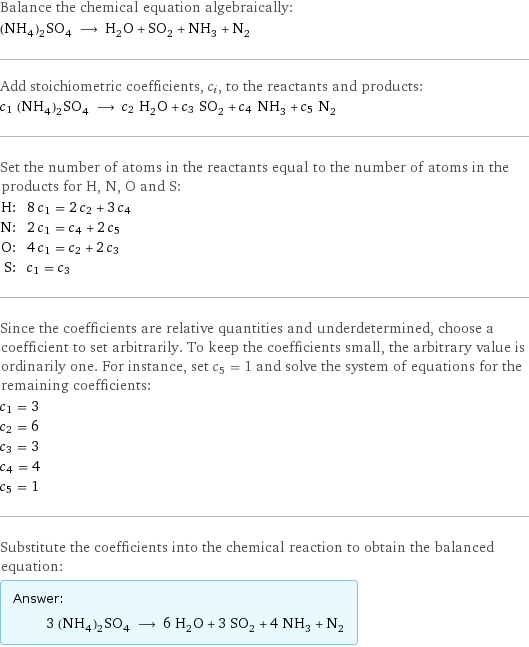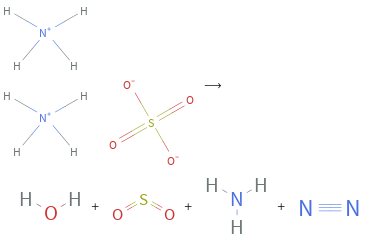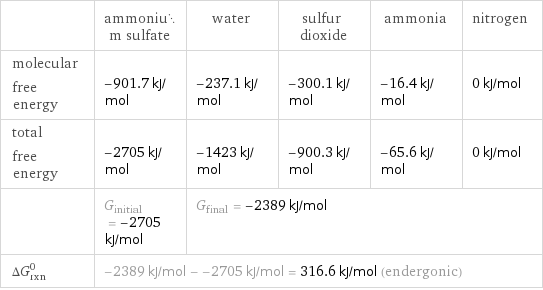Input interpretation

(NH_4)_2SO_4 ammonium sulfate ⟶ H_2O water + SO_2 sulfur dioxide + NH_3 ammonia + N_2 nitrogen
Balanced equation

Balance the chemical equation algebraically: (NH_4)_2SO_4 ⟶ H_2O + SO_2 + NH_3 + N_2 Add stoichiometric coefficients, c_i, to the reactants and products: c_1 (NH_4)_2SO_4 ⟶ c_2 H_2O + c_3 SO_2 + c_4 NH_3 + c_5 N_2 Set the number of atoms in the reactants equal to the number of atoms in the products for H, N, O and S: H: | 8 c_1 = 2 c_2 + 3 c_4 N: | 2 c_1 = c_4 + 2 c_5 O: | 4 c_1 = c_2 + 2 c_3 S: | c_1 = c_3 Since the coefficients are relative quantities and underdetermined, choose a coefficient to set arbitrarily. To keep the coefficients small, the arbitrary value is ordinarily one. For instance, set c_5 = 1 and solve the system of equations for the remaining coefficients: c_1 = 3 c_2 = 6 c_3 = 3 c_4 = 4 c_5 = 1 Substitute the coefficients into the chemical reaction to obtain the balanced equation: Answer: | | 3 (NH_4)_2SO_4 ⟶ 6 H_2O + 3 SO_2 + 4 NH_3 + N_2
Structures

⟶ + + +
Names

ammonium sulfate ⟶ water + sulfur dioxide + ammonia + nitrogen
Reaction thermodynamics
Enthalpy

| ammonium sulfate | water | sulfur dioxide | ammonia | nitrogen molecular enthalpy | -1181 kJ/mol | -285.8 kJ/mol | -296.8 kJ/mol | -45.9 kJ/mol | 0 kJ/mol total enthalpy | -3543 kJ/mol | -1715 kJ/mol | -890.4 kJ/mol | -183.6 kJ/mol | 0 kJ/mol | H_initial = -3543 kJ/mol | H_final = -2789 kJ/mol | | | ΔH_rxn^0 | -2789 kJ/mol - -3543 kJ/mol = 753.7 kJ/mol (endothermic) | | | |
Gibbs free energy

| ammonium sulfate | water | sulfur dioxide | ammonia | nitrogen molecular free energy | -901.7 kJ/mol | -237.1 kJ/mol | -300.1 kJ/mol | -16.4 kJ/mol | 0 kJ/mol total free energy | -2705 kJ/mol | -1423 kJ/mol | -900.3 kJ/mol | -65.6 kJ/mol | 0 kJ/mol | G_initial = -2705 kJ/mol | G_final = -2389 kJ/mol | | | ΔG_rxn^0 | -2389 kJ/mol - -2705 kJ/mol = 316.6 kJ/mol (endergonic) | | | |
Equilibrium constant
![Construct the equilibrium constant, K, expression for: (NH_4)_2SO_4 ⟶ H_2O + SO_2 + NH_3 + N_2 Plan: • Balance the chemical equation. • Determine the stoichiometric numbers. • Assemble the activity expression for each chemical species. • Use the activity expressions to build the equilibrium constant expression. Write the balanced chemical equation: 3 (NH_4)_2SO_4 ⟶ 6 H_2O + 3 SO_2 + 4 NH_3 + N_2 Assign stoichiometric numbers, ν_i, using the stoichiometric coefficients, c_i, from the balanced chemical equation in the following manner: ν_i = -c_i for reactants and ν_i = c_i for products: chemical species | c_i | ν_i (NH_4)_2SO_4 | 3 | -3 H_2O | 6 | 6 SO_2 | 3 | 3 NH_3 | 4 | 4 N_2 | 1 | 1 Assemble the activity expressions accounting for the state of matter and ν_i: chemical species | c_i | ν_i | activity expression (NH_4)_2SO_4 | 3 | -3 | ([(NH4)2SO4])^(-3) H_2O | 6 | 6 | ([H2O])^6 SO_2 | 3 | 3 | ([SO2])^3 NH_3 | 4 | 4 | ([NH3])^4 N_2 | 1 | 1 | [N2] The equilibrium constant symbol in the concentration basis is: K_c Mulitply the activity expressions to arrive at the K_c expression: Answer: | | K_c = ([(NH4)2SO4])^(-3) ([H2O])^6 ([SO2])^3 ([NH3])^4 [N2] = (([H2O])^6 ([SO2])^3 ([NH3])^4 [N2])/([(NH4)2SO4])^3](../image_source/437eaf23f07db20d0fcfa1780d5953b8.png)
Construct the equilibrium constant, K, expression for: (NH_4)_2SO_4 ⟶ H_2O + SO_2 + NH_3 + N_2 Plan: • Balance the chemical equation. • Determine the stoichiometric numbers. • Assemble the activity expression for each chemical species. • Use the activity expressions to build the equilibrium constant expression. Write the balanced chemical equation: 3 (NH_4)_2SO_4 ⟶ 6 H_2O + 3 SO_2 + 4 NH_3 + N_2 Assign stoichiometric numbers, ν_i, using the stoichiometric coefficients, c_i, from the balanced chemical equation in the following manner: ν_i = -c_i for reactants and ν_i = c_i for products: chemical species | c_i | ν_i (NH_4)_2SO_4 | 3 | -3 H_2O | 6 | 6 SO_2 | 3 | 3 NH_3 | 4 | 4 N_2 | 1 | 1 Assemble the activity expressions accounting for the state of matter and ν_i: chemical species | c_i | ν_i | activity expression (NH_4)_2SO_4 | 3 | -3 | ([(NH4)2SO4])^(-3) H_2O | 6 | 6 | ([H2O])^6 SO_2 | 3 | 3 | ([SO2])^3 NH_3 | 4 | 4 | ([NH3])^4 N_2 | 1 | 1 | [N2] The equilibrium constant symbol in the concentration basis is: K_c Mulitply the activity expressions to arrive at the K_c expression: Answer: | | K_c = ([(NH4)2SO4])^(-3) ([H2O])^6 ([SO2])^3 ([NH3])^4 [N2] = (([H2O])^6 ([SO2])^3 ([NH3])^4 [N2])/([(NH4)2SO4])^3
Rate of reaction
![Construct the rate of reaction expression for: (NH_4)_2SO_4 ⟶ H_2O + SO_2 + NH_3 + N_2 Plan: • Balance the chemical equation. • Determine the stoichiometric numbers. • Assemble the rate term for each chemical species. • Write the rate of reaction expression. Write the balanced chemical equation: 3 (NH_4)_2SO_4 ⟶ 6 H_2O + 3 SO_2 + 4 NH_3 + N_2 Assign stoichiometric numbers, ν_i, using the stoichiometric coefficients, c_i, from the balanced chemical equation in the following manner: ν_i = -c_i for reactants and ν_i = c_i for products: chemical species | c_i | ν_i (NH_4)_2SO_4 | 3 | -3 H_2O | 6 | 6 SO_2 | 3 | 3 NH_3 | 4 | 4 N_2 | 1 | 1 The rate term for each chemical species, B_i, is 1/ν_i(Δ[B_i])/(Δt) where [B_i] is the amount concentration and t is time: chemical species | c_i | ν_i | rate term (NH_4)_2SO_4 | 3 | -3 | -1/3 (Δ[(NH4)2SO4])/(Δt) H_2O | 6 | 6 | 1/6 (Δ[H2O])/(Δt) SO_2 | 3 | 3 | 1/3 (Δ[SO2])/(Δt) NH_3 | 4 | 4 | 1/4 (Δ[NH3])/(Δt) N_2 | 1 | 1 | (Δ[N2])/(Δt) (for infinitesimal rate of change, replace Δ with d) Set the rate terms equal to each other to arrive at the rate expression: Answer: | | rate = -1/3 (Δ[(NH4)2SO4])/(Δt) = 1/6 (Δ[H2O])/(Δt) = 1/3 (Δ[SO2])/(Δt) = 1/4 (Δ[NH3])/(Δt) = (Δ[N2])/(Δt) (assuming constant volume and no accumulation of intermediates or side products)](../image_source/fa4eb29a4681b126f4ac387cc0e05a08.png)
Construct the rate of reaction expression for: (NH_4)_2SO_4 ⟶ H_2O + SO_2 + NH_3 + N_2 Plan: • Balance the chemical equation. • Determine the stoichiometric numbers. • Assemble the rate term for each chemical species. • Write the rate of reaction expression. Write the balanced chemical equation: 3 (NH_4)_2SO_4 ⟶ 6 H_2O + 3 SO_2 + 4 NH_3 + N_2 Assign stoichiometric numbers, ν_i, using the stoichiometric coefficients, c_i, from the balanced chemical equation in the following manner: ν_i = -c_i for reactants and ν_i = c_i for products: chemical species | c_i | ν_i (NH_4)_2SO_4 | 3 | -3 H_2O | 6 | 6 SO_2 | 3 | 3 NH_3 | 4 | 4 N_2 | 1 | 1 The rate term for each chemical species, B_i, is 1/ν_i(Δ[B_i])/(Δt) where [B_i] is the amount concentration and t is time: chemical species | c_i | ν_i | rate term (NH_4)_2SO_4 | 3 | -3 | -1/3 (Δ[(NH4)2SO4])/(Δt) H_2O | 6 | 6 | 1/6 (Δ[H2O])/(Δt) SO_2 | 3 | 3 | 1/3 (Δ[SO2])/(Δt) NH_3 | 4 | 4 | 1/4 (Δ[NH3])/(Δt) N_2 | 1 | 1 | (Δ[N2])/(Δt) (for infinitesimal rate of change, replace Δ with d) Set the rate terms equal to each other to arrive at the rate expression: Answer: | | rate = -1/3 (Δ[(NH4)2SO4])/(Δt) = 1/6 (Δ[H2O])/(Δt) = 1/3 (Δ[SO2])/(Δt) = 1/4 (Δ[NH3])/(Δt) = (Δ[N2])/(Δt) (assuming constant volume and no accumulation of intermediates or side products)
Chemical names and formulas

| ammonium sulfate | water | sulfur dioxide | ammonia | nitrogen formula | (NH_4)_2SO_4 | H_2O | SO_2 | NH_3 | N_2 Hill formula | H_8N_2O_4S | H_2O | O_2S | H_3N | N_2 name | ammonium sulfate | water | sulfur dioxide | ammonia | nitrogen IUPAC name | | water | sulfur dioxide | ammonia | molecular nitrogen